Ever tried a guided meditation app? Ever wanted to make meditation a habit but struggled to do it consistently? We’ve been there. So we asked one of our writers to do what she had never done: Meditate every day with an app as her guide. And then tell us about it—Blair Witch Project style. (Kidding on the last part, but that would be a blog post to remember.) This is what happened.
I Used a Guided Meditation App for 14 Days in a Row. Here’s My Story
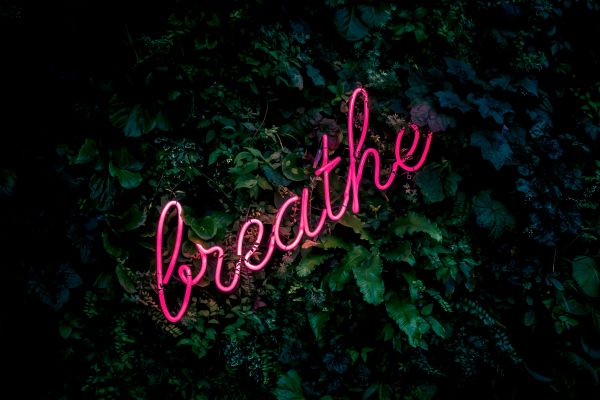
The Motivation
Within the same week, three separate people all suggested that I adopt a daily meditation practice. It sounded like a good idea and using a guided meditation app to do it sounded even better. It would take next to nothing to start and required little investment to reap fulfilling rewards (theoretically). But did I immediately download a mindfulness app? Of course not. It still took a few weeks for me to stop thinking, “I should have a regular meditation practice,” and actually do the damn thing. But one day I did. (Editor’s note: Because we low-key forced you.)
The App
Aura is one of the best guided meditation apps out there, so I chose to let it guide my journey. Beyond its clean interface, the app allows you to choose your mood from a list: “Sad, Anxious, Okay, Great, Stressed” and get a meditation tailored to that mindset. I found this helpful because I don’t always feel Zen when I sit down to meditate. In fact, I usually feel anxious or fidgety, and I was glad I was dealing with an app that understood me. The app also has a button for “Just Meditate,” presumably for when you’re feeling neutral (can’t imagine it) and just want to get on with things.
The Goal
I was hoping that using a guided meditation app daily would help:
- Manage my stress
- Keep me more grounded in the present
- Strengthen my ability to focus on tasks
- Prove that I could sit still for more than 120 seconds with my phone in reach and not scroll through Instagram
The Plan
Use the guided meditation app daily for two full weeks. I started with three-minute daily meditations so I didn’t get overwhelmed and discouraged right away.
And with that, the great experiment began.
Day 1:
Mood: Great
On Day 1, I was really confident about this thing, so I indicated that I was feeling “great” and allowed the meditation known as “Your Brilliant Heart” to take me away. The voice on Aura instructed me to think of my heart as a glowing orb in my body, whose light filled not only my body but my room, then my whole house, then my whole city, then my whole state, and the whole world.
I felt a little distracted during the meditation, mainly because I got caught up thinking about how big the jump was from state to world. It would make more sense to go from city to country to the continent to the world, but my brilliant heart is deeply powerful, I guess. Once I noticed I was distracted and pulled myself back to the present, the meditation was done. So, not a flawless start right off the bat, but I was feeling pretty good.
Day 2
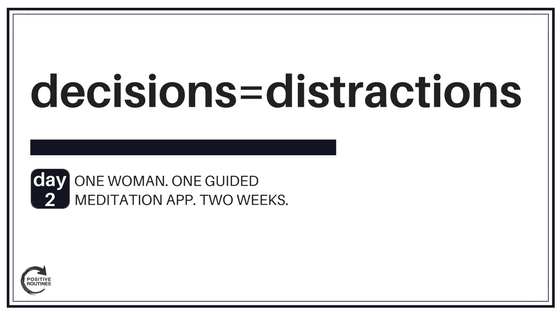
Mood: Sad
I was feeling bit moody when I woke up and selected “sad.” Aura generated a meditation called “Safe Space,” that asked me to select a safe space and imagine myself there. It was helpful when I finally selected my space, but that took me a while because I was deciding between a few different places.
Again, by the time I finished selecting a place and settled into it mentally, the meditation was over. BUT thinking about different places I felt at home in was relaxing and soothing. I made a note to myself to think about times and places I felt safe and calm the next time I was stressed.
Day 3
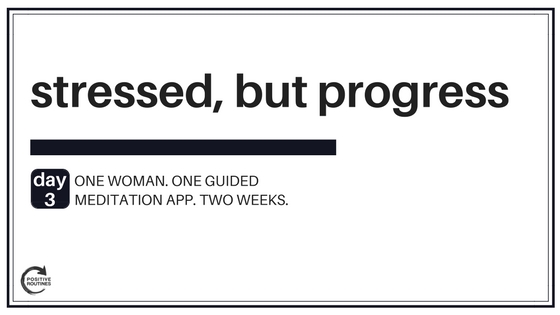
Mood: Stressed
I selected “stressed” this day—it was a weird week—and Aura gave me a three-minute meditation based on the idea that I am worthy of my journey. I actually stayed focused and engaged the whole time, which I know isn’t that impressive given that we’re talking three minutes, but progress is progress, right? Right.
Day 4
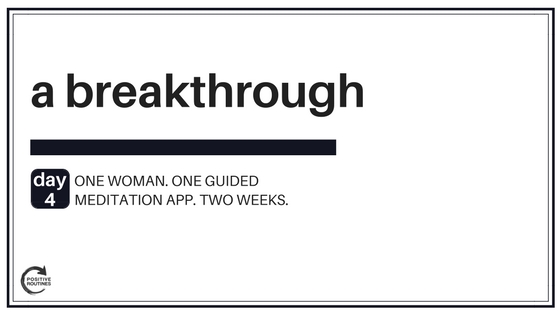
Mood: Stressed
I felt stressed again, which makes me seem like I have a lot more going on than I do, but I’d sort of been overscheduling myself. Aura gave me a meditation called “Experiencing Emotions Without Judgment.” Not only did I stay focused the whole time, it gave me A LOT to think about. For example, the idea of feelings being separate from me, as in “I am not my feelings.”
The meditation helped me feel like I didn’t have to change my stressed feelings—just observe and notice them. Incredibly, that actually helped the stressed feelings go away on their own.
Four days in and I was loving this practice.
Day 5
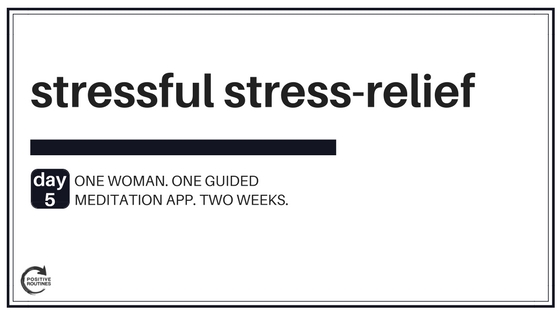
Mood: Sad
I was running late this day, so I saved the meditation for midday. I selected sad because I was feeling frustrated about something that was making me sad. Aura’s meditation instructed me to imagine sunlight on the top of my head and then allow it to work its way down my body “feeling it all over.”
I live in Los Angeles, have a fair complexion, and have a high skin cancer risk. So generally, when I feel the warmth of the sun covering every part of my body, I freak out and move to the shade. This meditation actually made me more stressed and concerned, but I guess it gets points for keeping me engaged the whole time.
Day 6
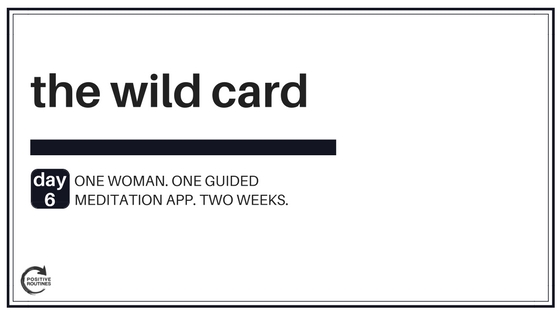
Mood: N/A (…didn’t choose a mood-based meditation this day)
I clicked “just meditate” and was brought to a guided meditation all about—wait for it—hands. I was surprised too. The voice asked me to have gratitude for my hands and all that they do for me, which honestly I had never done before.
When I realized how much I owe to them, I felt like kind of a jerk for not having been grateful sooner. I spent the entire meditation in rapt gratitude for my hands. And that led me to a manicure later that week—at the nice nail place.
Day 7
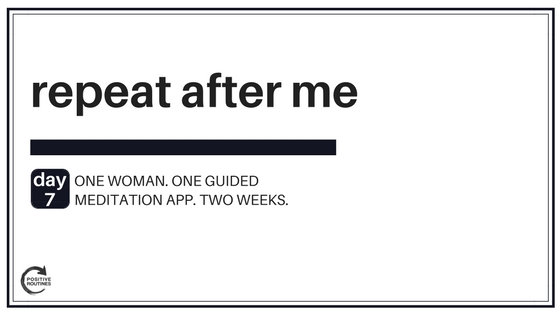
Mood: Okay
I was feeling okay so I selected “okay” as my mood. (See what I’m saying about a guided meditation app that understands me?) Aura brought me a short meditation where I repeated mantras to myself: “I am enough just as I am,” and “I am worthy of love and belonging.”
The words were spoken by an Australian lady who emphasized that I didn’t have to believe the words; I just needed to repeat them to let them sink into my being. I felt a little silly at first but the repetition of the meditation kept me focused the whole time.
Day 8
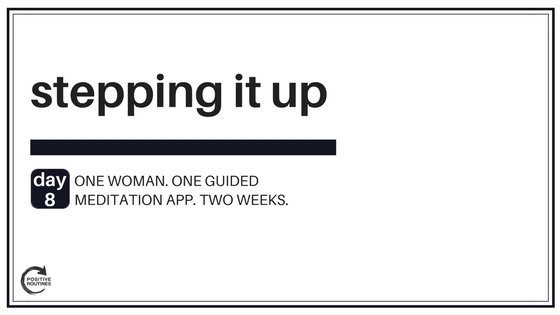
Mood: Stressed
After a week of short meditations, I decided I was ready to take it up a notch. I upgraded to Aura’s premium level like the baller I am and started my first seven-minute meditation.
I indicated that I was feeling “stressed,” and the app gave me a calm meditation centered around deep breathing and relaxation. It worked far better than I could have expected, and the increased time made a lot of difference. I was notably more focused and less anxious when the meditation ended.
Day 9
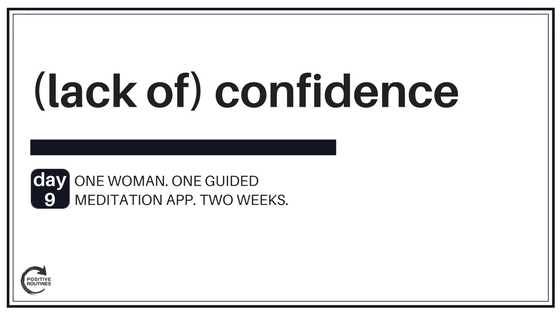
Mood: N/A (…didn’t choose a mood-based meditation this day)
After a deeply confidence-shattering morning of jeans shopping, I used Aura’s “explore” button to select a more specific meditation. I clicked on the appropriate category called “Self-love and Confidence.”
The meditation…wasn’t great. It was led by a guy who sounded like he was in an empty airplane hangar, telling me to repeat three mantras: “May I be safe and protected,” “May I be healthy and strong,” and “May I know the deepest happiness and peace.” I tried to repeat them to myself but it felt hollow and like I was just going through the motions.
Day 10
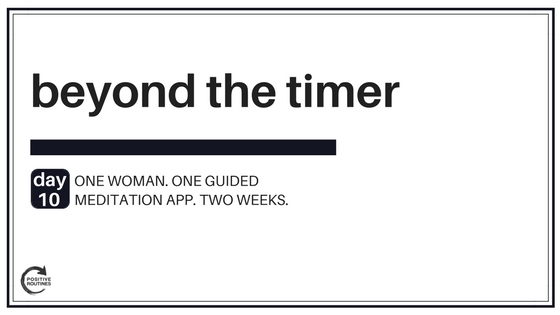
Mood: Okay
After selecting “okay” in the feelings section, Aura gave me a meditation about observing thoughts and emotions without getting caught up in them. So of course, I immediately got caught up in a thought. But I noticed it, pulled back, and realized that maybe this is what it’s all about—pulling back from engagement in thoughts, feelings, and actions and simply existing.
Then I realized the meditation timer had stopped, and I had been sitting there for five minutes thinking it was still on. Did I just beat the guided meditation app at its own game?
Day 11
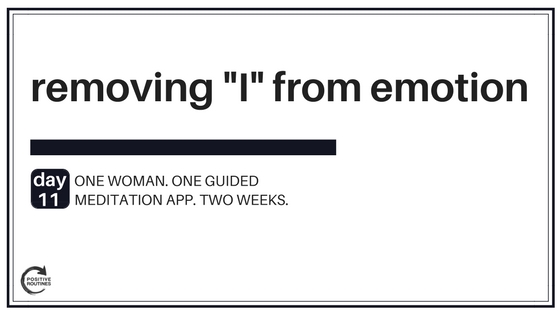
Mood: Anxious
I’d been anxiously stewing about some personal stuff related to boys, so I selected “anxious.” A nice Australian lady guided me through a seven-minute meditation where she guessed sympathetically and correctly that difficult emotions would come to the surface as I focused on my breathing.
She told me to cradle each one with compassion and then release it saying, “This is not me; this is not mine.” And so I did. It helped a little, and I liked the idea of separating myself from my feelings, which can be hard to do sometimes. That’s two for two on quality Australian-led meditations.
Day 12
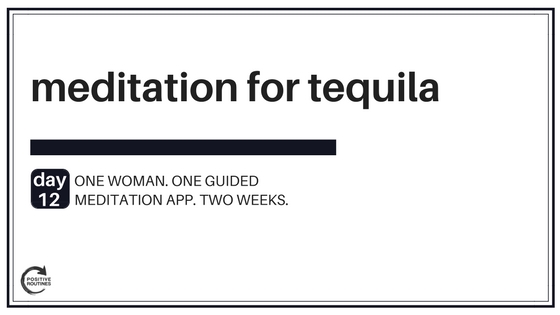
Mood: Anxious
I made the grave error of having three tequila-based drinks the night before—they were super acidic. I woke up around 4 a.m. with indigestion and could not get back to sleep. AND I had to wake up at 8 to go have brunch with a friend. I felt terrible.
I selected “anxious” and got a meditation that instructed me to sit in front of a table, stack my hands on the table, and lay my head onto my hands while breathing deeply. It wasn’t bad. The instructor then asked me to rub my palms together to “create warmth” and put my newly-warmed palms over my eyes. This was actually very soothing and helpful. I remained engaged and focused the whole time, possibly because I lacked the brainpower to do anything else.
Day 13
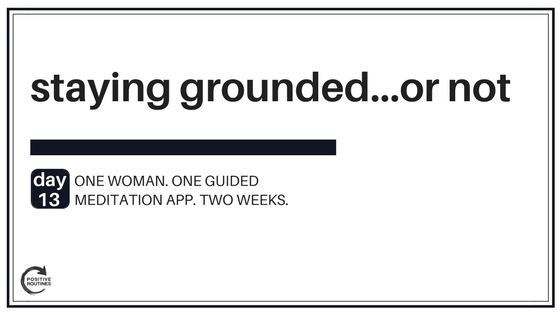
Mood: Anxious
I had more than normal anxiety this day because I was flying to Miami, and air travel is stressful for me. Due to a pre-dawn wake-up time, I used my guided meditation app bright and early.
I selected “anxious” because I was, and the meditation was all about….earth. Literally. Letting the earth take my stress. Settling into a comfortable position in the earth. Feeling the earth as it supports my body and mind. Allowing the earth to draw out all that was stressful and upsetting to me.
It felt a little auspicious seeing as I was about to, you know, lift off from the earth, leaving the safety and comfort of the ground behind. I began focusing on how odd and ironic of a choice this was considering that situation. It did not help, and I felt even more anxious.
Day 14
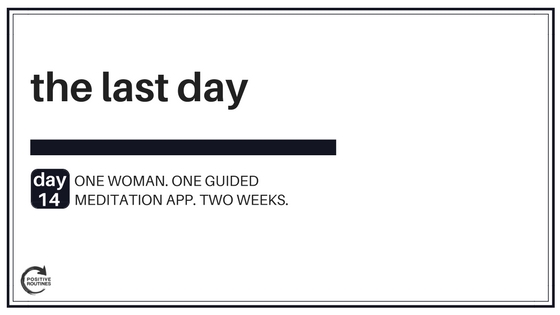
Mood: N/A (…didn’t choose a mood-based meditation this day)
For the last day of my experiment, I clicked “just meditate.” It took me to a seven-minute meditation led by a Southern lady named Candace. She began by stressing that all we have to worry about is the present because it is all we have. Okay, I’ve heard this before. But then she dropped this: “Sometimes we have to consider the past or anticipate the future in order to be most effective in the now.”
THANK YOU, CANDACE. My landlord likes to get paid every month, and if I’m not EVER thinking about the future, that might not happen. Candace then asked me to think about a stressful situation without delving too deeply into the story. I thought about a certain personal struggle relating to a past relationship. Candace urged me to feel my feelings, but then to imagine myself a month from now, a year from now, five years from now.
“Is it possible that the situation that is giving you stress now may seem remote then?” She asked. “Possibly even unimportant?”
Actually, yeah.
Candace went on: “Be aware as well that the feelings you have now are not going to be the same feelings you have in the future. Sit in that thought.” I did. I tried to accept the fact that the way I’m feeling today is simply how I’m feeling and not how things are or will be. I felt lighter when I returned to my day.
The aftermath
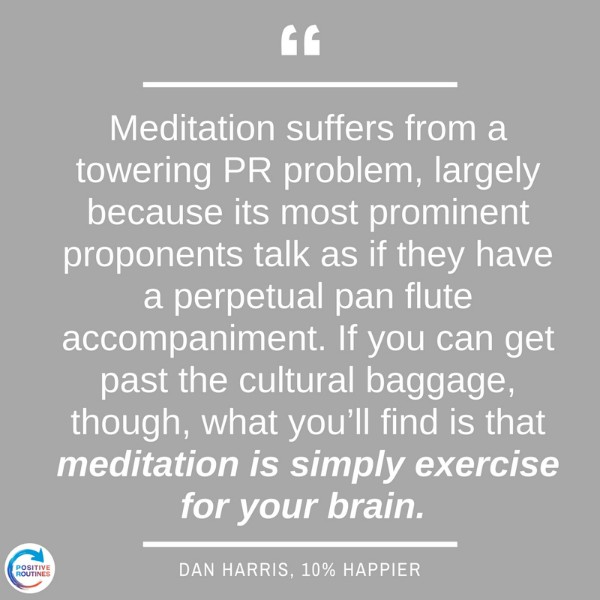
So, it seems like meditation should be easy, especially with the help of a guided meditation app. It’s literally just sitting and being…with someone telling you how to sit and be, right? Not exactly. It’s a practice. Focusing is a practice and detaching from thoughts is a practice too—one that requires way more concentration and discomfort than just sitting and being. Even with our Australian instructors leading the way. But pushing through that initial discomfort is worth it.
Why? Because with the discomfort comes benefits. In the two-week experiment, my concentration and focus improved, and I developed the ability to detach from unpleasant emotions. To realize that they weren’t me, they were just happening within me. And the less I fed them, the more quickly they passed. It sounds small but this was a significant insight for me, an often emotion-driven person. That alone made the time invested—which was technically just a little over an hour—well worth it.
I don’t know if I’ll meditate every single day going forward, but I’m definitely keeping this guided meditation app on my phone.
Your turn: Has a guided meditation app ever changed your life…okay, or just your day? Tell us about it in the comments.
If you’re looking for more mindfulness, check out our picks for best meditation apps.
Author: Ashley Friedman
Ashley Friedman is a writer and producer living in Los Angeles. She writes about culture, lifestyle, identity and the arts and has contributed to ManRepeller, Time Out New York, Refinery29. She loves restaurants, museums, and vintage shopping and has a really comfortable couch.

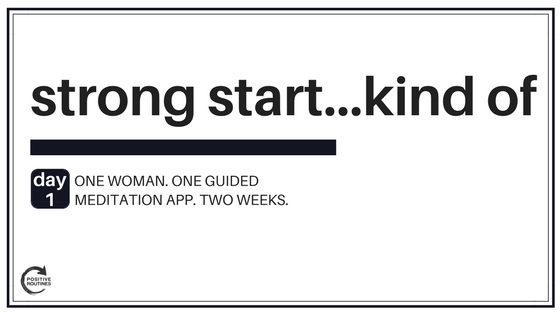
 Mike says
Mike says
September 26, 2019 at 11:51 pmMindfulness apps have been incredibly useful for me. I use Insight Timer whenever i’m not taking a meditation course through the Sounds True app. In 2016, a generous and industrious Australian names Melli O’Brien assembled the “Mindfulness Summit”. 31 days of free instruction in meditation from some of the most prominent teachers in the field. That experience changed my practice from a 20 year period of knowing meditation, but mostly not meditating to the past 4 years meditating almost daily.
 Chelsey Taylor says
Chelsey Taylor says
September 30, 2019 at 11:33 amThanks so much for the comment, Mike! That summit sounds like a truly transformative experience. We hope that meditation apps make practicing easier and more accessible for people who haven’t tried it before or want to build the habit. Glad they have helped you! Thanks again!